
views
- Do a warm-up jog and perform some dynamic stretches before you start doing any kind of sprint training.
- Perform flat sprinting exercises by running for 30 seconds at a time. Give yourself 2-5 minutes to rest in between each sprint, and increase intensity as you go.
- Perform hill sprinting exercises by sprinting up a hill at 50-70% intensity. Gradually increase your intensity as you continue.
- Walk or slowly jog for 5 minutes to help your body cool down after your sprint training.
Flat Sprints

Find a flat surface where you can run. Running on a track is the most popular place for sprint training because the distances are demarcated by lines on the ground, making it easy to keep track of exactly how far you’re running. The surface is also good for shock absorption, which is helpful for keeping your joints healthy and free of injury. If you don’t live near a school, gym, or other place with a track, you can still run sprints on any number of flat areas. Consider running on soccer field, football field, or another long stretch of grass or turf that is relatively flat. Depending on length and patterns of usage, you might also be able to find a parking lot or other paved area nearby that is relatively flat and would work well for sprinting. Look for an area at least 40 meters long. While pavement is not ideal for running, lots of people run marathons on the road, so a handful of sprints is surely a better option!
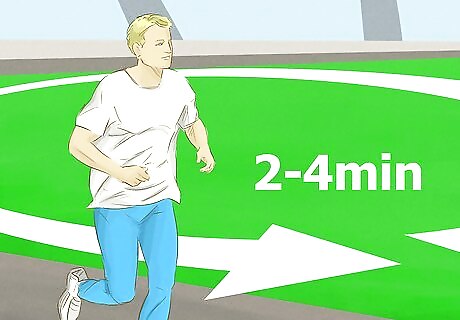
Jog one or two laps around the track. This will get your body warmed up and ready for more intense work. If you’re working out somewhere other than a track, try jogging for 2–4 minutes as a warm-up.

Do dynamic stretches. Doing a limited number of dynamic stretches before sprinting has been shown to improve sprint times and help the body avoid injury. Dynamic stretches are stretches performed while walking. Too much of this type of intense stretching will cause fatigue and decrease your sprinting performance, so aim to spend about 10 minutes if you’re in average shape, and up to 20 minutes if you’re super fit. Dynamic stretching requires more effort and is therefore more tiresome than the gentle stretches most people are familiar with. You don’t want to put in twenty minutes and expend all your energy—then you won’t have any left for sprinting! Here are a few stretches you can try: Gluteals – Walking High Knees Hamstrings – “Toy Soldiers” or “Frankensteins” Adductors – Hurdler’s Walk Quadriceps – “Butt-Kickers” Gastrocnemius – Tip-Toe Walking.

Start with a 30-second sprint. Thirty seconds is a good starting time, so long as you have a stopwatch or other device that can alert you when the time is up. Once you improve your stamina and speed, you can increase to longer time periods. If you don’t have an appropriate timing device, try sprinting for about 200m. If you’re not sprinting on a track and have no way of measuring the distance exactly, try counting your steps, aiming for between 120 and 130. This won’t give you exactly 200m/30 seconds, but it will put you reasonably close.
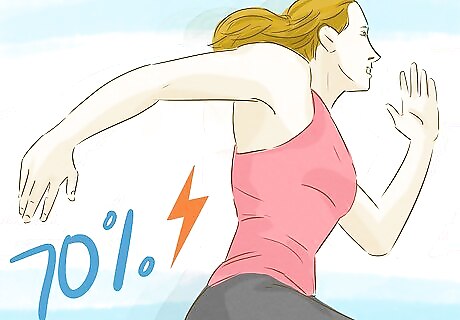
Do your first sprint at about 70% intensity, then increase. Don’t exert yourself to the full level of your capability right off the bat. Doing so can lead to injury, especially if you’re not using proper form or your muscles aren’t sufficiently warmed up. For your second sprint, increase to 80% intensity; after this, if you’re not experiencing joint or muscle pain (which are signs that you need to back off), you can increase to total or near-total intensity for the remainder for the session. Pain while sprinting could signal that you need more warm-up time or that you’re not using proper form.
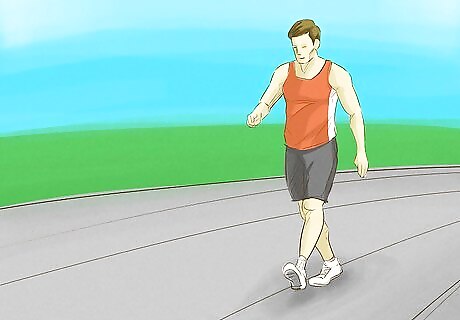
Rest for 2-5 minutes in between sprints. You need rest between sprints so that your body can recover and you can sprint at the same speed multiple times. You should rest 3 seconds for every 1 second that you sprinted. So, for example, if you sprinted for 30 seconds, you should rest for 90 seconds; if you sprinted for 60 seconds, rest for 3 minutes. Walking should be your form of “rest,” not sitting or standing. This will keep your muscles from cramping. Walk back to the place where you began your sprint, and you’ll be ready to start again. Sprinting is an intense exercise that will use up all of the oxygen in your muscles. You need adequate rest time between each sprint to maximize your speed and allow the oxygen to get back to your muscles. Otherwise you may feel nauseous and/or lightheaded.

Keep your first session short. Four sprints is plenty for your first sprinting session. This may not seem like a lot, but when this kind of intense work is new to your body, starting with too much too soon is a sure recipe for injury. After a few sessions you can gradually increase the number of sprints, eventually moving up to 8 or 9, depending on your individual fitness level and goals.
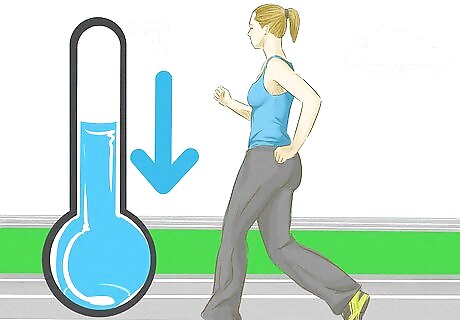
Cool down. Walk or slowly jog around the track for about 5 minutes to allow your heart rate to settle and help prevent cramping due to a build-up of lactic acid in your muscles.
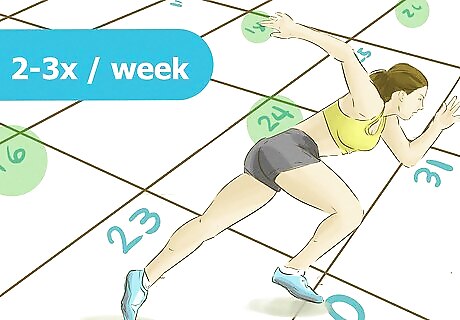
Perform your new sprinting routine 2 or 3 times a week. Because this is such a high-impact, high-intensity workout, it should be limited to a few times a week and you should allow at least 48 hours in between. While this might not seem like a lot, soon you will begin to see improvements in your running times as well as your breathing rates.Beyond that, the shape and tone of your body will quickly begin to improve as well!
Hill Sprints

Find a good hill where you can train. A good running hill will be fairly steep and at least 40 yards long. Unless you know of such a place (and its length) off the top of your head, you’ll probably want to drive around in your car and check out some nearby places. If you don’t have a car, then take a walk around the area or ride the bus if one is available. Depending on the hill you choose, you may need to consider traffic flow, availability of sidewalks or berms (if running on the road), lighting, foliage, and the general safety of the area that you will be running in. As with any athletic activity, it’s important to be aware of the conditions and plan your attire appropriately, including whether to running shoes or cross-trainers.
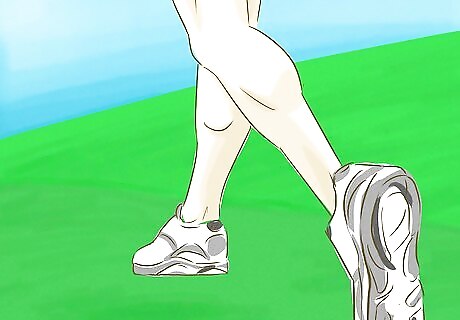
Warm up by jogging. Jog for 2–4 minutes on a flat area near the hill. If you really prefer it, however, you can do a light jog up and back down the hill to get your body ready for the sprinting workout.

Do dynamic stretches on a flat area. Even though you’ll be sprinting up the hill, you’ll want to do your stretching on flat ground so as not to over-tire yourself. Dynamic stretches are performed while walking, and you can help prevent injury if you do a limited number of these before beginning your sprinting workout. Aim to spend about 5–10 minutes stretching before doing hill sprints. Some particularly good stretches for this type of workout are high knees, butt kicks, and toy soldiers. Stretch until you feel energized—not fatigued.
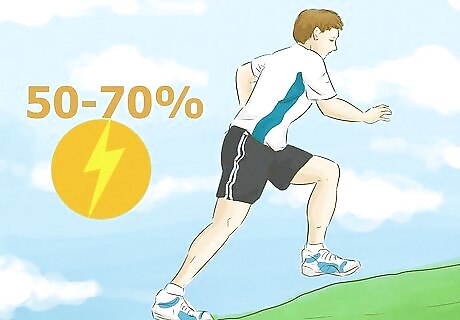
Run your first sprint at between 50-70% intensity. You can increase with each sprint, but only by about 10%. If you’re new to sprinting, or not in great shape, you may want to wait until the third or fourth session to go all-out on any of your sprints.

Rest between sprints. Walking down the hill will give your body time to recuperate between sprints. If you still feel too fatigued after getting to the bottom of the hill, walk on flat ground for another 15–30 seconds before beginning the next sprint.

Watch your form. Steeper hills require shorter strides and vice versa. It is important to pay attention to your running form so that you avoid injury. Don’t stare at the ground! Hold your chin at the normal level and keep your eyes looking forward. You should keep your torso upright and the balls of your feet should land directly under your chest. Do not lean forward when running. Hills sprints have a great fitness pay-off but are very challenging—if you’re unable to maintain proper form, then you should stop to avoid injury and over-work.
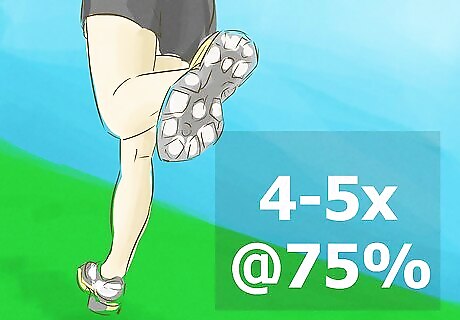
Take it easy the first time out. Hill sprints are more intense than sprinting on flat ground, so you shouldn't push yourself too hard during your first session. Try running 4 or 5 sprints at 75% intensity.
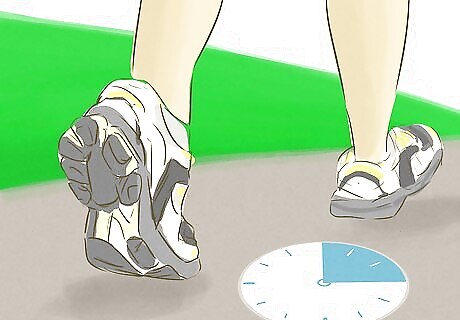
Cool down on some flat ground. Spend 5–10 minutes lowering your heart rate and keeping cramps at bay by walking or lightly jogging on flat ground.
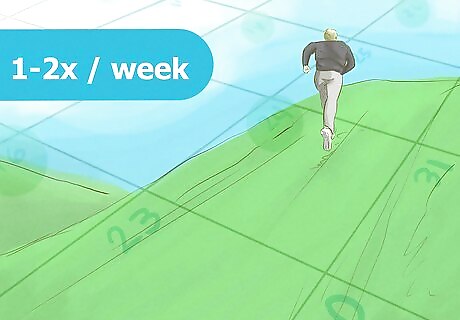
Do 1-2 sessions a week. Because it is such a high-intensity workout, you should aim for about two sessions of hill sprints a week, allowing two to three days in between each session so that your muscles have time to recover.



















Comments
0 comment